Shock Initiation Characteristics of Explosives at Near-ambient Temperatures
2016-05-08TANKaiyuanWENShanggangHANYong
TAN Kai-yuan, WEN Shang-gang, HAN Yong
(1. Institute of Chemical Materials, CAEP, Mianyang 621999, China; 2. Robust Munitions Center, CAEP, Mianyang 621999, China)
1 Introduction
2 Experimental
2.1 Experimental Set-up
The experimental set-up used to study the shock initiation process in explosives at various near-ambient temperatures is shown in Fig.1. A planewave lens with additional booster explosive was used to create a high-pressure shock wave in the inert materials. With the proper choice of explosive and inert materials, the pressure of the shock wave entering the test sample can be tailored. In this study, the booster explosive was a HMX-based high explosive with detonation pressure of 36 GPa. The inert materials consisted of two layers; the lower layer was an aluminum plate, which was also a part of the sample heater or cooler. The upper layer was a Teflon plate, which worked as an adiabatic layer to keep the booster explosive from heating or cooling. The sample assembly consisted of several explosive discs, gauge packages containing manganin pressure gauges were embedded between individual discs[8-11].

Fig.1 Experimental set-up used to study the shock initiation process in explosives at various initial temperatures near ambient
1—detontor, 2—explosive planewave lens, 3—booster explosive,4—teflon plate, 5—aluminium plate, 6—heater or fan cooler,7—temperature controller, 8—themocouple, 9—manganin gauges
An electric-stove heater was used to heat the bottom and top of the explosive plates. And a gap (1.0 mm) existed between sample side surface and the heater to avoid confinement when the samples expand with heat. A thermocouple was located at the center of samples to monitor inner temperature of the test explosives. Both the heater and thermocouple were connected to a temperature controller, which could control the heat rate and ensure the sample to be heated to a preset temperature. In this work, the heat rate was about 5 ℃·min-1. For the low
temperature conditions, a fan cooler was designed separately to cool samples to the temperature below ambient. Similar to the heater, the fan cooler was also controlled by the temperature controller and cool the samples at the rate of about 3 ℃·min-1.
2.2 Experimental Conditions
To study the effects of near-ambient temperature changes on the shock initiation behavior of explosives, it is necessary to make sure that the input conditions for each kind of explosive are almost the same at different initial temperatures. Table 1 shows the details of experiment information for PBX-1 (a HMX/TATB composite explosive) and PBX-2 (a TATB based insensitive high explosive).
It is clear from Table 1 that in this work the input systems of shock initiation experiments for each kind of explosive are highly uniform. The density at 20 ℃ of each material was floatation measured and had a high degree of uniformity. However, it is worth noting that the lower insert layer (Al plate), which is used to tailor the input pressure, has difference in thickness for the two explosives (a 35 mm thick Al plate for PBX-1 and a 23 mm thick Al plate for PBX-2 ). Besides, the shock initiation tests under four temperature conditions (5, 20, 40 ℃and 75 ℃) have carried out for PBX-1 but three temperature conditions (5, 40 ℃and 75 ℃) for PBX-2.
Table 1 Information of shock initiation experiments at different temperatures for PBX-1 and PBX-2

samplestemperature/℃densityofsample/g·cm-3boosterexplosivetheupperinertlayerthelowerinertlayerdepthofpressuregauges/mmPBX-1PBX-25204075540751.851.90Ф50mm×50mmPBX9505withdensityof1.86g·cm-3Ф50mm×10mmTeflonwithdensityof2.16g·cm-3Ф50mm×35mmAlplatewithdensityof2.70g·cm-3Ф50mm×23mmAlplatewithdensityof2.70g·cm-30,3,6,9
3 Reactive Flow Modeling
The ignition and growth reactive flow model of shock initiation and detonation has been used to understand many shock initiation and detonation studies of solid explosives and propellants in several 1D, 2D, and 3D codes.[12-13]The model uses two Jones-Wilkins-Lee (JWL) equations of state, one for the unreacted explosive and the other for the reaction products, in the temperature-dependent form:
(1)
(2)
WherepEandpPare the pressure, GPa (the subscript E represent the unreacted explosive, and the subscript P represent the reaction products);Vis relative volume, cm3;T0is temperature of the unreacted explosive,K;TPis temperature of the reaction products,K;ωis the Grueneisen coefficient,CVis the average heat capacity, GPa·K-1;A,B,R1andR2are constants. The unreacted explosive equation of state is fitted to the available shock Hugoniot data, and the reaction product equation of state is fitted to cylinder test and other metal acceleration data.
当上述两种翻译方法都不能满足翻译的要求时,就需要使用意译翻译法。这与我国传统教学中只可意会,不可言传的方法类似,将句子中潜藏的意思挖掘出来并加以翻译,例如“a wet blanket”是指一个人没有情调,而不是英文词汇表示的原本的湿毛毯的意思。因此在我们学习过程中遇到翻译不通的句子时,可尝试使用意译法。
The reaction rate law for the conversion of explosive to products is
0 (3) WhereFis the fraction reacted,tis time in μs,ρis the current density in g·cm-3,ρ0is the initial density, g·cm-3;pis the pressure, GPa; andI,G1,G2,a,b,c,d,e,g,x,y,z,Figmax,FG1max, andFG2minare constants. This three-term reaction rate law represents the three stages of reaction generally observed during shock initiation and detonation of pressed solid explosives[14].Table 2 contains the modeling parameters for PBX-1 and PBX-2, and the Grueneisen parameters used for the inert materials are listed in Table 3. The shock initiation pressure evolution for the two explosives were measured using embedded manganin gauges over the temperature range from 5 ℃ to 75 ℃. Fig.2 shows the measured pressure histories at the four gauge positions(0,3,6,9 mm) in PBX-1 under the conditions of 5, 20, 40 ℃ and 75 ℃ respectively. It can be found from Fig.2 that the input pressure (the pressure of shock wave entering the test samples), which is measured by the first manganin gauges at 0mm depth, is about 10 GPa for all the four temperature conditions. The gauge records show rapid pressure increases, indicating the rapid growth of shock wave. Fig.3 shows the peak pressure of gauges at different depth under the four temperature conditions, and Fig.4 shows the time for shock wave running from 0 mm to 9 mm under the four temperature conditions. Table 2 Ignition and growth modeling parameters for PBX-1 and PBX-2 parametersunreactedJWLPBX-1PBX-2A/GPa9.32×1057.781×104B/GPa-5.35-4.8R114.1011.30R21.411.13w0.88670.8867CV/GPa·K-12.781×10-32.487×10-3T0/K298298parametersproductJWLPBX-1PBX-2A/GPa852.4654.67B/GPa18.027.1236R14.64.45R21.31.2w0.380.35CV/GPa·K-11.0×10-31.0×10-3E00.1020.069reactionratesparametersPBX-1PBX-2parametersPBX-1PBX-2a00.22b0.6670.667c0.2770.667d0.6670.111e0.3330.333g1.01.0x20.07.0y2.01.0z2.03.0I7.4×10114.0×106Figmax0.30.5FG1max0.50.5FG2min0.50G148.00.48G2400400 Table 3 Grueneisen parameters for inert materials inertρ/g·cm-3shearmodul/GPaC/km·s-1S1S2S3γ0aTeflon2.1602.331.681.1232.98-5.80.590Al2.70327.65.241.4001.970.48 a. 5 ℃b. 20 ℃ c. 40 ℃d. 75 ℃ Fig.2 Measured pressure histories at the four gauge positions in PBX-1 under different temperature conditions Fig.3 The peak pressure of gauges at different depth of PBX-1 under the four temperature conditions Fig.4 The time for shock wave running from 0mm to 9mm depth of PBX-1 under the four temperature conditions It can be found from Fig.3 that when shock wave (or detonation wave) running to 9 mm depth of the samples, no increase in peak pressure occurs for the conditions of 40 ℃ and 75 ℃, however, for 5 ℃ and 20 ℃, the peak pressure grows to about 34 GPa, which is close to the detonation pressure of PBX-1. These results indicate that when the PBX-1 is impacted by a shock wave of about 10 GPa at near-ambient temperatures, the run distance to detonation is between 6 mm and 9 mm for 5 ℃, about 6 mm for 20 ℃ and between 3 mm and 6 mm for 40 ℃ and 75 ℃. Besides, from Fig.4, it can be found that the time for shock wave running from 0 mm to 9 mm decreases as the initial temperature increases. All the results above clearly show that the near-ambient temperature changes affect shock initiation characteristics of the PBX-1: as temperature changing from 5 ℃ to 75 ℃, the pressure in shock front grows more rapidly, the run distance to detonation becomes shorter, and the PBX-1 becomes more sensitive to shock. For this trend, one reasonable cause may has been that the thermal expansion with heat led to a higher concentration of voids or other defects in the samples, these can increase the “hot spots” and consequently make the explosives easier to be initiated. Fig.5 shows the measured pressure histories at the four gauge positions in PBX-2 under the conditions of 5, 40 ℃ and 75 ℃ respectively. It can be seen from Fig.5 that the input pressure is about 15 GPa for all the three temperature conditions. Fig. 6 shows the peak pressure of gauges at different depth under the three temperature conditions, and Fig.7 shows the time for shock wave running from 0 mm to 9 mm under the three temperature conditions. a. 5 ℃b. 40 ℃ c. 75 ℃ Fig.5 Measured pressure histories at the four gauge positions in PBX-2 under different temperature conditions Fig.6 The peak pressure of gauges at different depth of PBX-2 under the three temperature conditions Fig.7 The time for shock wave running from 0 mm to 9 mm depth of PBX-2 under the three temperature conditions From Fig.6, it can be found that when shock wave (or detonation wave) running from 6 mm to 9mm depth of the PBX-2 samples, no increase in peak pressure occurs for the conditions of 40 ℃ and 75 ℃, however, for 5 ℃, the peak pressure grows to about 30 GPa, which is close to the detonation pressure of PBX-2. And from Fig. 7, it can be seen that the time for shock wave running from 0 mm to 9 mm depth of PBX-2 decreases as the initial temperature increases. These results also indicate that, similar to PBX-1, the near-ambient temperature changes affect shock initiation behavior of the insensitive explosive PBX-2: as temperature increasing from 5 ℃ to 75 ℃, the pressure in shock front grows more rapidly, the run distance to detonation becomes shorter, and the PBX-2 becomes more sensitive to shock. The ignition and growth simulation of the shock initiation of PBX-1 at 5, 20 ,40 ℃ and 75 ℃ are illustrated in Fig.8 , respectively. Fig.9 shows the comparison of experimental and calculated results for the shock initiation of PBX-2 at 5 , 40 ℃ and 75 ℃, respectively. From Fig.8 and Fig.9 it is quite evident that the ignition and growth model simulates experimental records quite well and can be reliably used to describe the shock ignition process involving high explosive PBX-1 and insensitive high explosive PBX-2 at temperature range from 5 ℃ to 75 ℃. While most of the modeling constants remain unchanged, only few of them require a change depending on the temperature. These constants are shown in Table 4. It can be found from Tables 4 that the unreacted JWL constantBdecreases with an increase of temperature, however the reaction rate model constantG1increases as temperature increases, indicating that both of PBX-1 and PBX-2 react more rapidly as temperature changing from 5 ℃ to 75 ℃. This is consistent with previously published shock initiation experiments and calculations on other explosives.[3] In contrast to the experiments, which provide limited data on shock pressure at only four positions of the samples, the numerical simulations provide more detailed information on the shock initiation processes. Fig.10 show the calculated shock pressure profiles at various depth of PBX-1 for 20 ℃ and 75 ℃ conditions respectively. From this figure the detailed growth processes of shock waves have been clearly presented, and it can be found from Fig.10 that the run distance to detonation is about 6 mm for 20 ℃ but 4.5 mm for 75 ℃. a. 5 ℃b. 30 ℃ c. 40 ℃d. 75 ℃ Fig.8 Experimental and calculated pressure profiles in the shock initiation of PBX-1 at different temperatures a. 5 ℃b. 40 ℃ c. 75 ℃ Fig.9 Experimental and calculated pressure profiles in the shock initiation of PBX-2 at different temperatures Table 4 Ignition and growth modeling parameter changes for PBX-1 at different temperatures explosivetemperature/℃unreactedJWLconstantB/GPareactionrateconstantG1/GPaγ·μs-15-5.22×1024.8×105PBX-120-5.35×1024.8×10540-5.38×1025.0×10575-5.40×1025.5×1055-4.69×1024.6×103PBX-240-4.80×1024.8×10375-4.85×1025.1×103 a. 20 ℃ b. 75 ℃ Fig.10 Calculated shock pressure profiles in the shock initiation of PBX-1 at different temperatures Based on the ignition and growth modeling parameters calibrated by the experiments, it is possible to numerically simulate the shock initiation processes of samples which are impacted by various input pressures and obtain the “pop plot”. The relative shock sensitivity of PBX-1 and PBX-2 at different initial temperatures is illustrated on the “pop plot” shown in Fig.11. The “pop plot” represents a plot of run distance to detonation as a function of impact pressure in a log-log space. The closer the points are to the origin of the plot the more sensitive the explosive is to shock pressure. From Fig.11 a clear progression from least sensitive at 5 ℃ to most sensitive at 75 ℃ for both of PBX-1 and PBX-2 is observed. In fact, for the same input pressure, the run distances to detonation of PBX-1 and PBX-2 at 75 ℃ are about 30% and 20% shorter than that of PBX-1 and PBX-2 at 5 ℃ respectively, this indicates that the effects of near-ambient temperature changes on the safety of the explosives cannot be ignored. Fig.11 Pop-plot for PBX-1 and PBX-2 at different initial temperatures (1) As temperature changing from 5 ℃ to 75 ℃, the shock initiation pressure in both of the two PBXs grew more rapidly, the run distance to detonation became shorter and the reaction rate model constantG1increased gradually, these indicated that the two explosives became more sensitive to shock as near-ambient temperature increasing. (2) The reasons for the samples at higher initial temperature being more sensitive to shock were: thermal expansion which led to lower density and the creation of more voids within the explosives and thus more hot spots to initiate reaction and faster growth of these hot spots into the surrounding particles and consequently made the explosives easier to be initiated. (3) The effects of near-ambient temperature changes on safety of explosives could not be ignored. [1] Mulford R N, Alcon R R. Shock initiation of PBX9502 at elevated temperatures[C]∥Shock Compression of Condensed Matter, AIP Conference Proc. Seattle,WA, 1995. [2] Urtiew P A, Tarver C M. Shock initiation of energetic materials at different initial temperatures[C]∥Combustion, Explosion, and Shock Waves: Proceedings of the Conference of the American Physical Society, 2005, 41(6): 766-776. [3] Chen Lang, Liu Qun, Wu junying. On shock initiation of heated explosives[J].ExplosionandShockWaves. 2013, 33(1): 21-27. [4] Urtiew P A, Tarver C M, Forbes J W , et al. Shock sensitivity of LX-04 at elevated temperatures[C]∥Shock Compression of Condensed Matter, AIP Conference Proc. New York 1997: 727-730. [5] Tarver C M, Forbes J W , Urtiew P A, et al. Shock sensitivity of LX-04 at 150 ℃[C]∥Shock Compression of Condensed Matter-1999, AIP Conference Proc. Snowbird, UT, 2000: 891-894. [6] Urtiew P A, Cook T M, Tarver C M, et al. Shock sensitivity of IHE at elevated temperatures[C]∥Tenth International Detonation Symposium, Boston, MA, 1993: 139-147. [7] Chi Jiachun, Liu Yusheng, Gong Yanqing, et al. Investigation of shock pressure evolution of initiation in IHE’s JB9014 at ambient and -54 ℃[J].ChineseJournalofHighPressurePhysics, 2001, 15(1): 39-47. [8] Urtiew P A, Forbes J W, Tarver C M, et al. Calibration of manganin pressure gauges at 250 ℃[C]∥ Shock Compression of Condensed Matter-1999, AIP Conference Proc. Snowbird, UT, 2000: 1019-1022. [9] Urtiew P A, Erickson L M, Hayes B, et al. Pressure and particle velocity measurements in solids subjected to dynamic loading[J].Combustion,ExplosionandShockWaves, 1986, 22: 597-614. [10] Urtiew P A, Tarver C M, Maienschein J L, et al. Effect of confinement and thermal cycling on the shock initiation of LX-17[J].CombustionandFlame, 1996, 105: 43-53. [11] Forbes J W, Tarver C M, Urtiew P A, et al. The effects of confinement and temperature on the shock sensitivity of solid explosives[C]∥11th International Detonation Symposium, Snowmass, CO, 1998: 147-152. [12] Tarver C M, Hallquist J O, Erickson L M. Modeling short pulse duration shock initiation of solid explosives[C]∥Proceedings, Symposium (International) on Detonation, 8th; Naval Surface Weapons Center NSWC MP86-194; Office of Naval Research, Washington, DC, 1985: 951-961. [13] Tarver C M, Forbes J W, Gaarcia F, et al. Manganin gauge and reactive flow modeling study of shock initiation of PBX9501[C]∥Shock Compression of Condensed Matter-1999, AIP Conference Proc. Atlanta, GA, 2000: 1043-1046. [14]Tarver C M, Breithaupt R D, Kury J W, Current experimental and theoretical understanding of detonation waves in heterogeneous solid explosives[C]∥International Symposium on Pyrotechnics and Explosives, Beijing, China, October 12-15, 1987: 692.4 Results and Discussion
4.1 Experimental Results


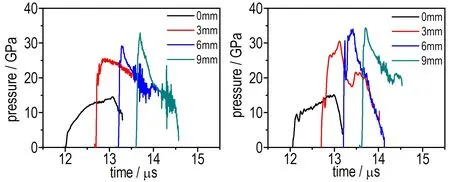




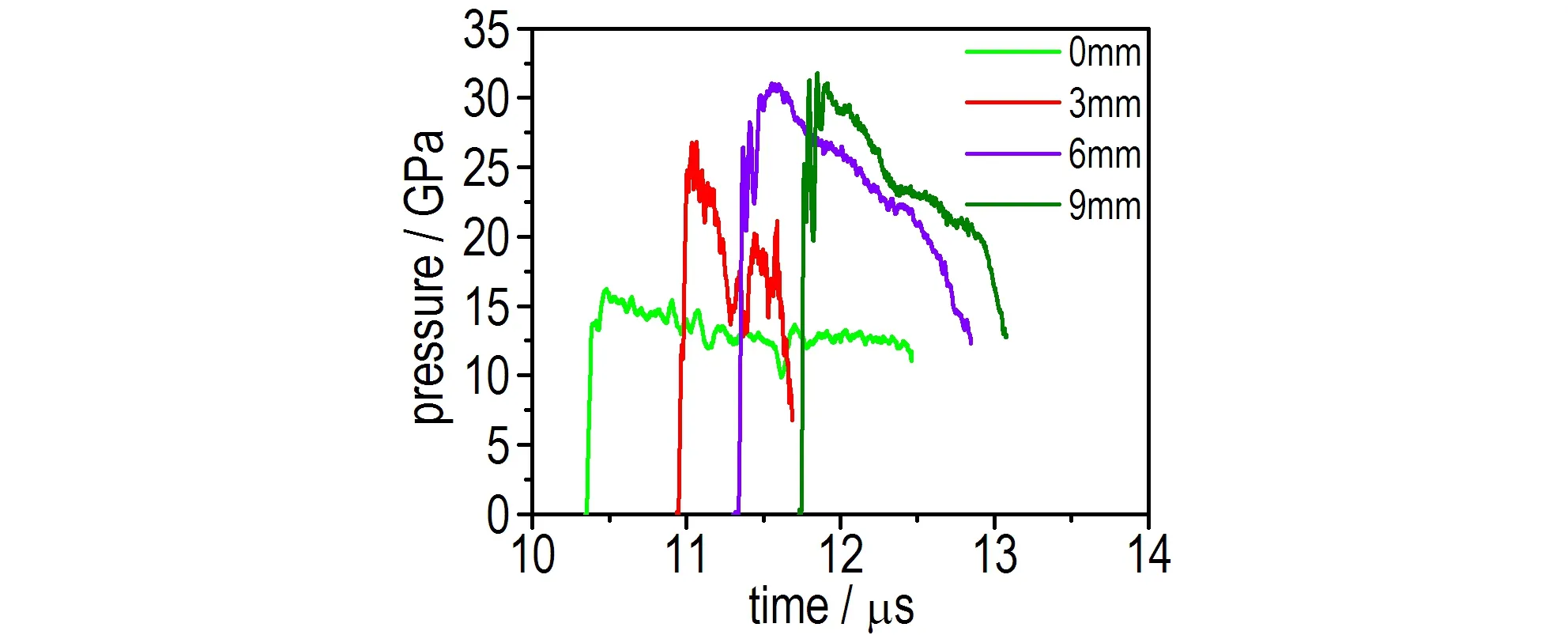


4.2 Comparison of Experimental and Calculated Results
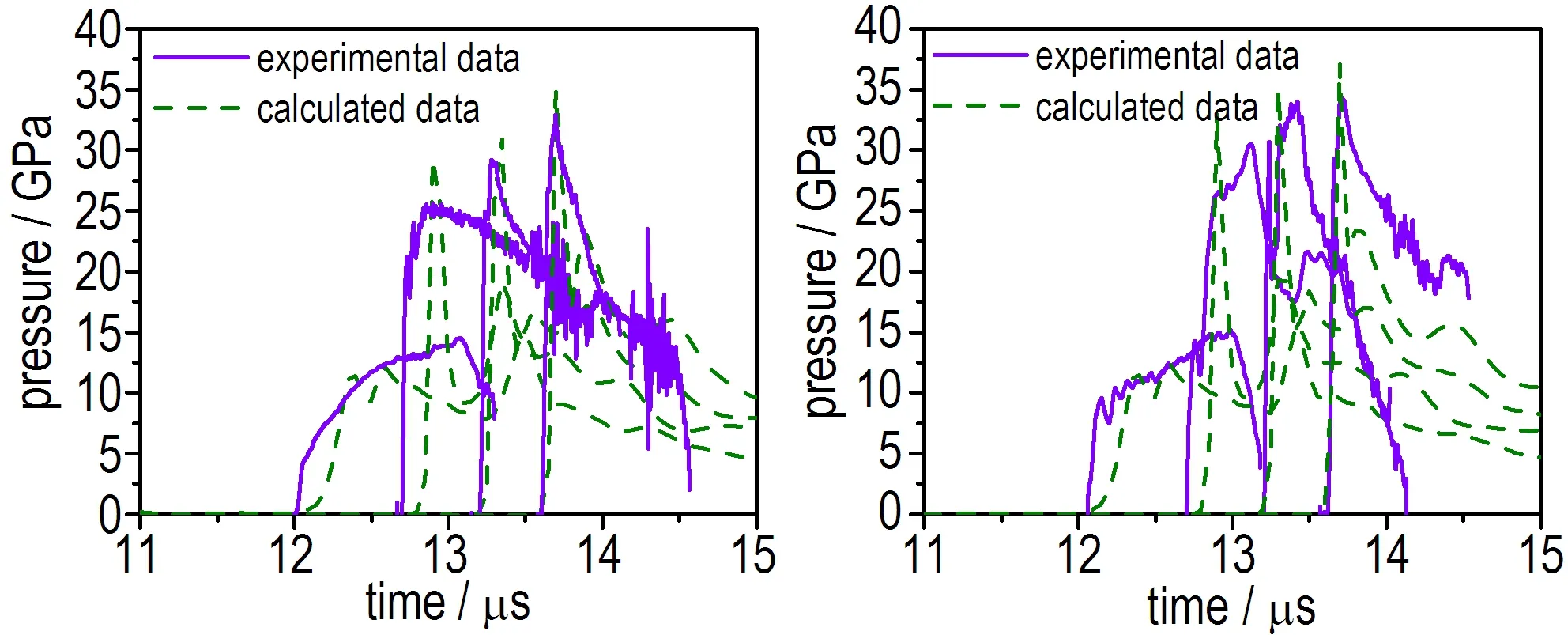



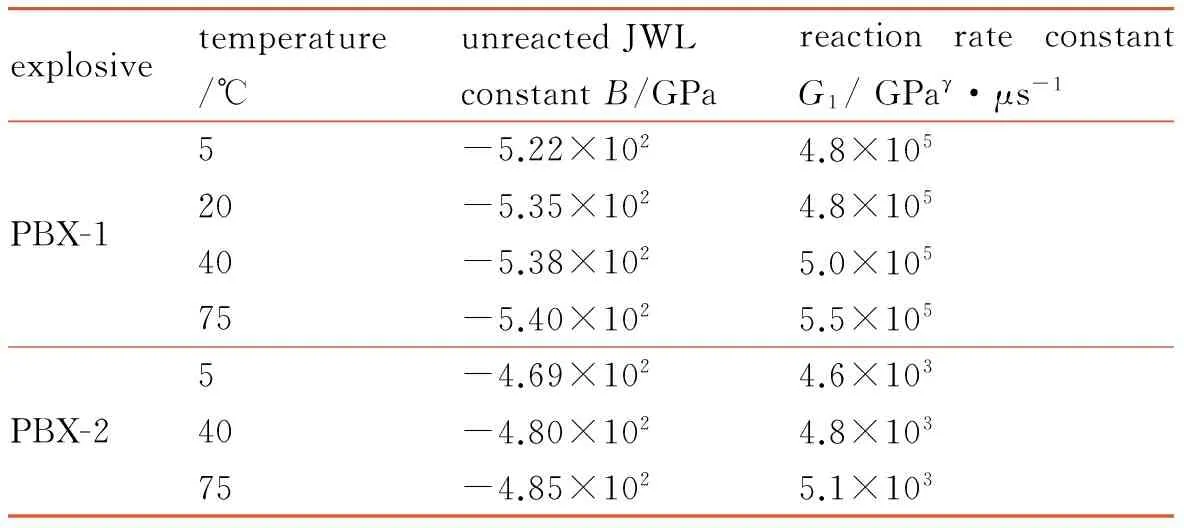
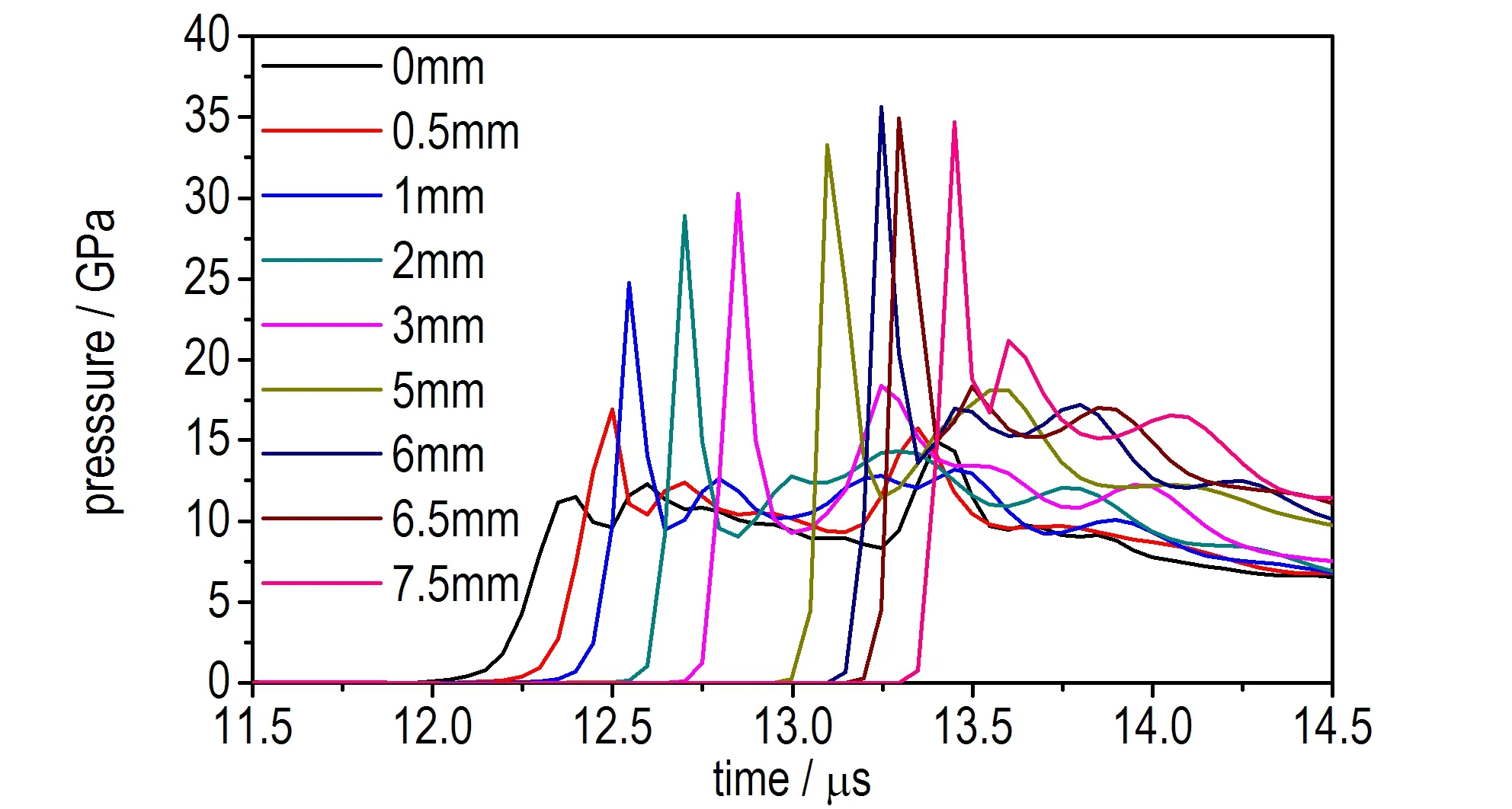
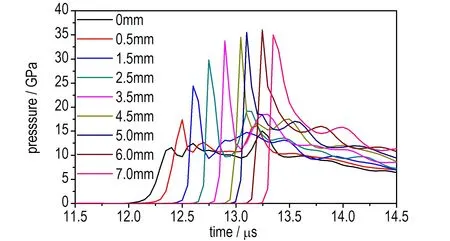

5 Conclusions
猜你喜欢
杂志排行
含能材料的其它文章
- Synthesis and Properties of 5-(3-Amino-1,2,5-oxadiazol-4-yl)tetrazol-1-ol and Its Ammonium and Hydroxylammonium Salts
- Coatings of Activated Metal Hydride and Application in the Fuel-rich Propellant
- An Insensitive Energetic Compound 5,7-Diamino-4,6-dinitrobenzotriazol-3-ium-1-oxide: Synthesis, Characterization and Performances
- The Tensile Properties and Creep Performance of a Long-term Thermally Aged Plastic Bonded Explosive
- Energies of Combustion and Specific Heat Capacities of Diaminofurazan, Dinitrofurazan and Diaminoazofurazan
- Thermal Behaviors of 1-Amino-2-nitroguanidine
